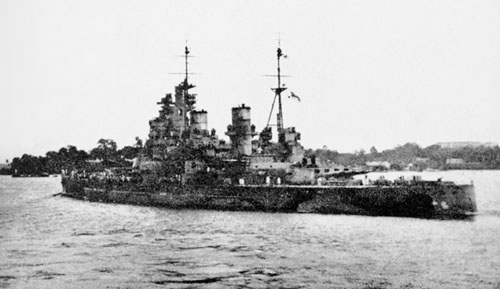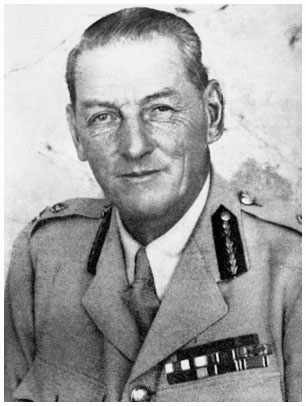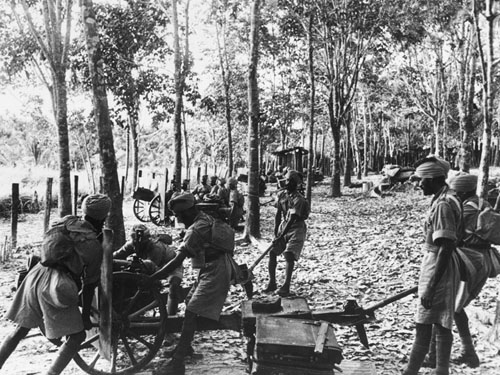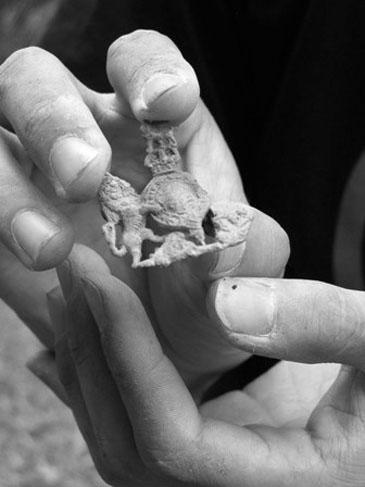Battle Story (4 page)
Authors: Chris Brown

HMS
P
RINCE OF
W
ALES
Weighing over 37,000 tons, armed with ten 14in guns and with a top speed of over 28 knots (32mph), HMS
Prince of Wales
was one of the most modern battleships in the world, but the day of the battleship was long past. She was launched in May 1939 and was not yet complete when the war started. She came close to being destroyed in a German air raid in 1940 while she was still being fitted out. She was in action against the
Bismarck
and suffered damage which was repaired at Rosyth before being assigned to transport the prime minister, Winston Churchill, to a conference with President Roosevelt. On 10 December 1941 she was attacked by Japanese ‘Betty’ torpedo bombers, with the loss of over 300 of her 1,500-man crew.
Prince of Wales
and
Repulse
were the first warships of their respective classes (battleship and battlecruiser) to be sunk by aircraft while at sea. American and Italian ships had been sunk by air power whilst in port at Taranto and Pearl Harbor.

Although there was a general reluctance to accept that there would be war with Japan, it was decided that a strong naval presence in Singapore might act as a deterrent and that the force of one heavy cruiser, four light cruisers (of First World War vintage) and three destroyers currently based at Singapore should be reinforced with the battleship
Prince of Wales
and the battlecruiser
Repulse
. A plan to supplement the force with the aircraft carrier
Indomitable
had to be abandoned when she ran aground near Jamaica.
Repulse, Prince of Wales
and four destroyers – known collectively as ‘Force Z’ – arrived in Singapore on 2 December 1941, only a week before the Japanese landings. The arrival of Force Z was a boost to the confidence of the British establishment and played well in the local press, but the absence of an aircraft carrier would prove to be a great weakness when battle was joined.
The naval base was a significant military and political asset, but it was not a fortification and was not defensible in isolation. As early as 1940, Percival’s predecessor as GOC Malaya Command – Lt Gen. Lionel Bond – was well aware that Singapore could not be held securely without possession of the rest of Malaya, and that this could not be achieved without a strong army and, crucially, large numbers of aircraft.
The airfields to support an extensive air force had already been built, but the demands of the other theatres meant that only a small number – and none of the more advanced models – could be spared for Malaya. At the time of the Japanese attack there was a total of only 158 RAF aircraft in the region, although it had been suggested as early as October 1940 that a force of nearly 600 front-line aircraft was required. In addition to being woefully understrength in quantity, the RAF presence was also of poor quality. Only one-third of the aircraft in front-line service were fighters; all of them Brewster Buffaloes. The Buffalo suffered from several weaknesses: pilot protection was very poor; it was slow and prone to fuel problems at higher altitudes and to overheating. To make matters worse, when the Japanese struck nearly half of the fifty-two Buffaloes in the reserve stock were out of action through problems with a new engine design.
B
REWSTER
B
UFFALO
The Brewster F2A Buffalo was originally intended to serve as a carrier-borne fighter for the United States Navy, but was not a success. Considerable numbers were acquired by the British and Netherlands Royal Air Forces for pilot training and as a stop-gap measure in Asia due to the demands for Spitfires and Hurricanes in other theatres. The Buffalo was not a match for the Japanese Navy’s ‘Zero’ or the Imperial Army’s Oscar, but performed reasonably well against the army Nakajima Ki-27 ‘Nate’ fighter. Attempts to improve the Buffalo’s performance by fitting lighter guns – Browning .30 calibre in place of the original .50 calibre – and carrying less fuel and ammunition came to nothing. Buffaloes were flown from stations in Singapore and Malaya by Australian, New Zealand and British squadrons.
The rest of the combat aircraft consisted of a mixture of Blenheim bombers and twenty-four thoroughly obsolete Vickers Vildebeests. The situation was not helped by a general shortage of spare parts to keep the aircraft flying or by the lack of combat experience among the crews. Of the aircraft available, only the Blenheim was not outclassed by its Japanese counterparts, but without adequate fighter protection they would prove terribly vulnerable to the Zero and Oscar fighters of the enemy. Additionally, expectations were unrealistically high in the first days of the conflict. To an extent this was probably a legacy of the Battle of Britain in 1940, but there were two other factors: repeated claims that the Buffalo was more than a match for anything the Japanese had to offer, and that Japanese pilots were not particularly competent, not being able fly at night because
of racially congenital eyesight problems. If the RAF was under-equipped in fighters and bombers, the situation was no better in regard to reconnaissance. Only three Catalina and seventeen Hudson aircraft were in service with another two Catalinas and seven Hudsons in reserve. RAF reconnaissance was effective at the beginning of the campaign, but although the approaching Japanese fleet was identified from the air by a Hudson on 6 December no action was taken by Far East Command.
If Singapore was to be protected the airfields would need to be securely defended with thousands of men, but there would also need to be a powerful field army to repel an invasion by sea or overland from Thailand. Given the needs of the European and North African theatres, it was abundantly clear that troops would be increasingly hard to come by as the war progressed, but Percival was not actually short of troops; he was short of troops with sufficient training and he was short of adequate equipment.
Percival’s immediate superior was General Archibald Wavell. The two men did not always see eye-to-eye on the general approach to the campaign, and Wavell’s appreciation of the situation was not always very realistic. He did not know either the country or the troops and, initially, held the Japanese armed services in poor regard. Percival’s relationship with his subordinates was not altogether positive either.
The chief assets of Malaya Command were III Indian Corps under Lieutenant General Sir Lewis Heath; 8th Australian Division under Major General Gordon Bennett; Singapore Fortress under Major General Keith Simmons; and 12th Indian Brigade under Brigadier Paris. Heath’s position in the command structure was a difficult one. Unlike his colleagues – or his superior – he had recent senior battlefield experience as commander of 5th Indian Division in North Africa. He had very different views about the conduct of the campaign to Percival and suffered from his commander’s general lack of respect for the Indian Army, of which General Heath was a product. His command covered the whole of northern Malaya and was, at best, an unwieldy structure. In addition to two divisions (9th and 11th Indian, though each had only two brigades instead of three) and the 28th Indian Independent Brigade, Heath had responsibility for Penang Fortress and three battalions assigned to airfield defence. Major General Barstow’s 11th Division was stationed between Alor Setar and Sadao in the north-east, 40 miles away from divisional headquarters near Butterworth. The 9th Division was rather more scattered, with 8th Brigade at Kota Bahru and 22nd Brigade nearly 200 miles south at Kuantan. Although both brigades were on the east coast, divisional headquarters had been placed close to Heath’s own HQ in the vicinity of Kuala Lumpur, on the other side of the country. The remaining formation, 28th Indian, was at Ipoh, roughly equidistant from the other concentrations of the corps.
Sir Lewis Heath
Heath was born in 1885. He joined the Indian Army in 1906 and served until his retirement in 1946, save for the period between 1909 and 1913, when he served with the King’s African Rifles. After the First World War he served in Persia and Afghanistan and was appointed to command 1st Battalion, 11th Sikh Regiment in 1930. He was an instructor on the staff of the Indian Army’s Senior Officers’ School at Belgaum from 1934–36.
At the outbreak of war in 1939 he was the commander of the 5th Indian Division based at Secunderabad. At that point the division consisted of two brigades, each of three battalions of Indian infantry. In 1940 5th Division was transferred to the Sudan, where it was joined by three British infantry battalions so that each brigade would have two Indian and one British battalion, which was the normal practice for Indian formations throughout the Second World War. The division served with some distinction in Eritrea in 1940, and in Egypt and Iraq in 1941, and it was from there that Heath – known widely as ‘Piggy’ – was appointed as commander of III Indian Corps in Malaya Command. Heath did not share his superior’s views on the conduct of the campaign but was generally as supportive of Percival as he could be. He was taken prisoner in February 1942 and spent the next three and a half years in captivity in Taiwan and Manchuria.


8. Indian mountain gunners in training.

Bennett’s 8th Australian Division, also of just two brigades, lay further to the south; 22nd Australian Brigade (Brigadier Taylor) was to the north of Mersing and 27th Australian Brigade (Brigadier Maxwell) near Kluang. Percival had distributed his forces widely to ensure that there were troops at all of the places most likely to be attacked, but in doing so had also ensured that none of his formations was in a position to move quickly to the support of any other.
If the general deployment was weak, contingency planning was no better. Arrangements had been made for a mobile force (to be known as
Krohcol
) to enter Thailand in the event of Japanese landings and to occupy a hillside road position known as ‘the Ledge’. The plan was sound: blocking the Ledge would undoubtedly stall the Japanese advance for a time and allow formations to be brought into the battle in a rational and effective manner, but there was no means of ensuring that the plan – Operation Matador – could be launched in time to
secure the position. Additionally, little had been done to prepare for attack. Modest beach defences had been erected at various points, though many of them – notably those to the south of Kota Bahru – were only dummies.